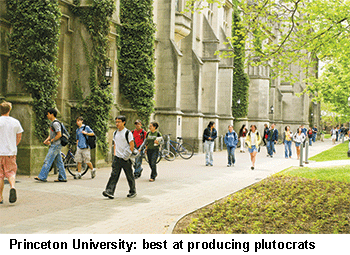 New data on American universities and their role in economic mobility — culled from 30 million tax returns — published by Raj Chetty, an economist at Stanford University and colleagues, show that some colleges do a better job of boosting poor students up the income ladder than others. Previously, the best data available showed only average earnings by college. For the first time, the entire earnings distribution of a college’s graduates — and how that relates to parental income — is now known.
New data on American universities and their role in economic mobility — culled from 30 million tax returns — published by Raj Chetty, an economist at Stanford University and colleagues, show that some colleges do a better job of boosting poor students up the income ladder than others. Previously, the best data available showed only average earnings by college. For the first time, the entire earnings distribution of a college’s graduates — and how that relates to parental income — is now known.
These data show that graduates of elite universities with single-digit admission rates and billion-dollar endowments are still the most likely to join the top 1 percent (though having wealthy parents improves the odds). And despite recent efforts to change, their student bodies are still overwhelmingly wealthy.
Princeton University is the best at producing plutocrats — 23 percent of its graduates end up as one-percenters, about the same as the share of its students who hail from equally wealthy households. Following closely are the University of Pennsylvania, Harvard and Stanford where this rich-in, rich-out model works well. But no matter their family income, students at America’s most prestigious universities have a roughly equal chance of reaching the top 20 percent of income distribution. Reaching the top 1 percent is a different story altogether.
In this case, having a trust fund is useful. Even if a student attends an elite university, the chances of eventually reaching the 1 percent economic elite increase greatly with the wealth of parents. A rich student from a household in the top 5 percent, has about a 60 percent greater chance of reaching the income summit than a poor student, whose parents were in the bottom 5 percent, even if they both attended one of America’s most esteemed universities. Elite financial and consulting firms, which often recruit for highly paid positions exclusively at Ivy League-calibre colleges and rely on networking, bear some of the blame.
Elite universities justify steep rises in tuition fees by pointing to their generous financial-aid programmes for poor students. Harvard’s most recent fundraising campaign passed the $7 billion mark, partially by focusing on expanding financial aid. Parents with incomes under $65,000 (Rs.43.5 lakh) aren’t expected to pay a cent. But the data show that between 1999-2013, poor students’ access to the university has stayed stubbornly low (more than half of Harvard students came from the richest 10 percent of households), and just 2 percent of Princetonians came from households at the bottom 20 percent of the income distribution.
Legacy admissions, which give preferential treatment to family members of alumni, exacerbate the imbalance. Of Harvard’s most recently admitted class, 27 percent of students had a relative who also attended. There’s evidence this system favours the already wealthy. MIT and the California Institute of Technology, two elite schools with no legacy preferences, have much fewer students who hail from the ranks of the super-rich.
“The dirty secret of elite colleges is that for all the positive talk about the importance of racial diversity, low-income students of all races are essentially shut out,” says Richard Kahlenberg of the think-tank Century Foundation. Despite all the spending on financial aid, the Ivies are still doing a poor job of finding and educating bright, poor students.